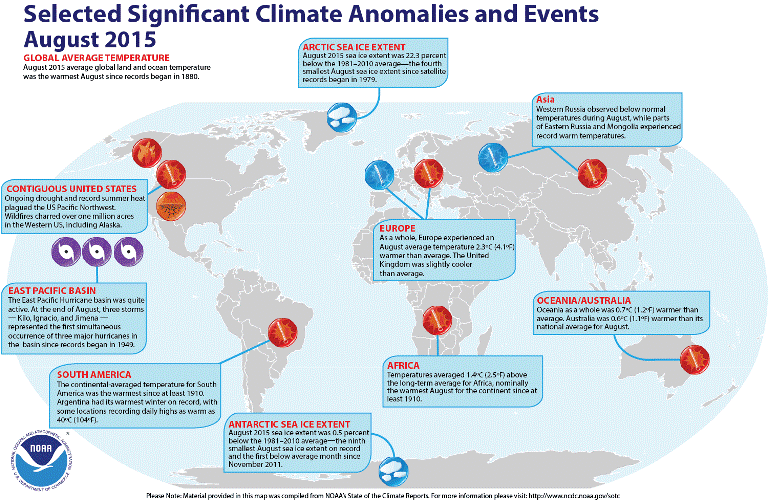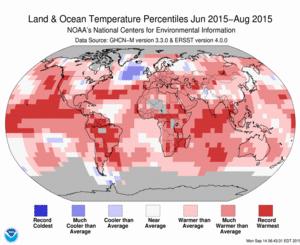Summary Information
The Monthly Report Summary Information is a synopsis of the collection of national and global summaries released each month.
« Global Summary Information 2015Full Report »
Global Summary Information for August 2015
Global average temperature record high for August, June–August, and January–August;
Separately, global oceans and global land were both highest on record for these periods of time
The globally averaged temperature over land and ocean surfaces for August 2015 was the warmest August on record, 1.58°F (0.88°C) warmer than the 20th century average, and surpassing the previous record set in 2014 by 0.16°F (0.09°C). August 2015 tied with January 2007 as the third warmest monthly highest departure from average for any month since record keeping began in 1880. The combined global average land and ocean surface temperature for January–August was also record warm.
Global highlights: August 2015
- The August average temperature across global land and ocean surfaces was 1.58°F (0.88°C) above the 20th century average—the warmest August on record, surpassing the previous record by +0.16°F (+0.09°C). This was the sixth month in 2015 that has broken its monthly temperature record (February, March, May, June, July, and August).
- The August globally-averaged land surface temperature was 2.05°F (1.14°C) above the 20th century average. This was the highest for August in the 1880–2015 record, besting the previous record set in 1998 by +0.23°F (+0.13°C). Record warmth was observed across much of South America and parts of Africa, the Middle East, Europe, and Asia.
- The August globally-averaged sea surface temperature was 1.40°F (0.78°C) above the 20th century average. This was the highest temperature for any month in the 1880–2015 record, surpassing the previous record set in July 2015 2014 by +0.07°F (+0.04°C). Large portions of the seven seas (where temperature records are available) recorded much-warmer-than-average temperatures, with some locations across all oceans experiencing record warmth.
- El Niño conditions were present across the tropical Pacific Ocean during August 2015. According to analysis by the NOAA's Climate Prediction Center, there is a greater than 90 percent chance that El Niño will continue through Northern Hemisphere winter 2015/16.
- The average Arctic sea ice extent for August 2015 was 620,000 square miles (22.3 percent) below the 1981–2010 average. This was the fourth smallest August extent since records began in 1979, according to analysis by the National Snow and Ice Data Center using data from NOAA and NASA.
- Antarctic sea ice extent during August 2015 was 30,000 square miles (0.5 percent) below the 1981–2010 average. This marks a shift from recent years when Antarctic sea ice extent was record and near-record large. This is the first month since November 2011 that the Antarctic sea ice extent was below average.
Global highlights: Seasonal (June–August 2015)
- The June–August average temperature across global land and ocean surfaces was the highest such period since records began in 1880, at 1.53°F (0.85°C) above the 20th century average. This surpassed the previous record set in 2014 by 0.20°F (0.11°C).
- The globally-averaged land surface temperature for June–August 2015 was 1.98°F (1.10°C) above the 20th century average—the highest for June–August in the 1880–2015 record, besting the previous record set in 2010 by +0.13°F (+0.07°C). Record warmth was observed across much of South America, and parts of Africa, the Middle East, Asia, and the western contiguous U.S.
- The June–August globally-averaged sea surface temperature was 1.35°F (0.75°C) above the 20th century average and the highest departure from average for the season in the 1880–2015 record. This value exceeded the previous record set in 2014 by +0.11°F (+0.06°C). Large portions of the eastern equatorial Pacific Ocean, the Indian Ocean, and parts of the Atlantic Ocean had record warm temperatures.
- The year-to-date temperature across global land and ocean surfaces was 1.51°F (0.84°C) above the 20th century average. This was the highest for January–August in the 1880–2015 record, surpassing the previous record set in 2010 by 0.18°F (0.10°C).
- The year-to-date globally-averaged land surface temperature was the highest for January–August in the 1880–2015 record at 2.32°F (1.29°C) above the 20th century average. This value exceeded the previous record of 2007 by 0.29°F (0.16°C). Much of the world's land surface experienced much-warmer-than-average conditions during the first eight months of the year, with much of South America and parts of North America, Africa, Europe, and Asia experiencing record warmth.
- The year-to-date globally-averaged sea surface temperature was 1.22°F (0.68°C) above the 20th century average and the highest for January–August in the 1880–2015 record. This value surpassed the previous record of 2014 by +0.13°F (+0.07°C). A large portion of the northeastern and equatorial Pacific Ocean observed record warmth, while the other major basins observed record warmth in some areas.
Global highlights: Year-to-date (January–August 2015)
For extended analysis of global temperature and precipitation patterns, please see our full August report
 NOAA's National Centers for Environmental Information
NOAA's National Centers for Environmental Information



